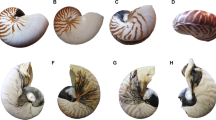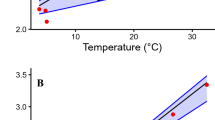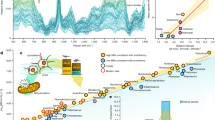Abstract
THE cephalopod mollusc Nautilus is often called a living fossil because its multichambered shell resembles that of extinct forms from the early Palaeozoic era. Living at depths of 100–300 m, the animals not only encounter zones of low oxygen concentration, but also exploit them for refuge or feeding1,2. Despite some modest recruitment of anaerobic sources of energy, Nautilus is able to survive severe bouts of hypoxia, mainly through its prodigious capacity for aerobic metabolic rate suppression. Here we show that the hypometabolic, hypoxic animal conserves energy further by means of prolonged ventilatory and circulatory pauses, during which time the blood, having a comparatively high oxygen affinity, is apparently loaded at the venous side, across the superficially located and voluminous vena cava. Under these highly arrested conditions, a significant fraction of the animal's aerobic metabolic rate can be accounted for by a slow 'metering out' of the O2 store contained in the shell, indicating that the buoyancy chambers of Nautilus may occasionally subserve the role of a 'SCUBA tank'. The internal shell morphology and siphuncular arrangement seen in the fossilized remains of ammonites suggest that similar processes may have occurred.
This is a preview of subscription content, access via your institution
Access options
Subscribe to this journal
Receive 51 print issues and online access
$199.00 per year
only $3.90 per issue
Buy this article
- Purchase on Springer Link
- Instant access to full article PDF
Prices may be subject to local taxes which are calculated during checkout
Similar content being viewed by others
References
O'Dor, R. K., Forsythe, J., Webber, D. M., Wells, J. & Wells, M. J. Nature 362, 626–627 (1993).
Wells, M. J., Wells, J. & O'Dor, R. K. J. mar. biol. Ass. U.K. 72, 313–328 (1992).
Hochachka, P. W. & Guppy, M. Metabolic Arrest and the Control of Biological Time 227 (Harvard Univ. Press, Cambridge, MA, 1987).
Storey, K. B. & Storey, J. M. Quart. Rev. Biol. 45, 145–174 (1990).
Denton, E. J. & Gilpin-Brown, J. B. J. mar. biol. Ass. U. K. 46, 723–759 (1966).
Denton, E. J. Proc. R. Soc. Lond. B185, 273–299 (1974).
Ward, P. D. The Natural History of Nautilus 267 (Allen & Unwin, Boston, 1987).
Johansen, K., Redmond, J. R. & Bourne G. B. J. exp. Zool. 205, 27–36 (1978).
Redmond, J. R., Bourne, G. B. & Johansen, K. J. exp. Zool. 205, 45–50 (1978).
Wells, M. J. Veliger 30, 69–75 (1987).
Berry, W. B. N. & Wilde, P. Am. J. Sci. 278, 257–275 (1984).
Wilde, P. & Berry, W. B. N. Paleogeogr. Paleoclimatol. Paleoecol. 48, 143–162 (1984).
Wells, M. J. Mar. Freshwat. Behav. Physiol. 25, 1–12 (1994).
Jacobs, D. K. & Landman, N. H. Lethaia 26, 101–111 (1993).
Pörtner, H. O., Webber, D. M., O'Dor, R. K. & Boutilier, R. G. Am. J. Physiol. 265, R157–165 (1993).
Hochachka, P. W., Hartline, P. H. & Fields, J. H. A. Science 195, 72–74 (1977).
Hochachka, P. W. & Somero, G. N. Biochemical Adaptation 537 (Princeton Univ. Press, Princeton, NJ, 1984).
Grieshaber, M. K., Hardewig, I., Kreutzer, U. & Pörtner, H.-O. Rev. Physiol. Biochem. Pharmacol. 125, 43–147 (1994).
Boutilier, R. G., Randall, D. J., Shelton, G. & Toews, D. P. Resp. Physiol. 32, 381–388 (1978).
Author information
Authors and Affiliations
Rights and permissions
About this article
Cite this article
Boutilier, R., West, T., Pogson, G. et al. Nautilus and the art of metabolic maintenance. Nature 382, 534–536 (1996). https://doi.org/10.1038/382534a0
Received:
Accepted:
Issue Date:
DOI: https://doi.org/10.1038/382534a0
This article is cited by
-
Chamber volume development, metabolic rates, and selective extinction in cephalopods
Scientific Reports (2020)
Comments
By submitting a comment you agree to abide by our Terms and Community Guidelines. If you find something abusive or that does not comply with our terms or guidelines please flag it as inappropriate.



